If your doctor handed you a bottle of besifloxacin eye drops and said, "Use this for your eye infection," but you’re not sure how to actually make it work - you’re not alone. Many people struggle with getting the most out of antibiotic eye drops, even when they’re prescribed something as effective as besifloxacin. The truth? It’s not just about putting the drops in. It’s about how you put them in, when you use them, and what you avoid doing afterward. Get it wrong, and the infection might not clear up. Get it right, and your eyes could feel better in just a few days.
What Besifloxacin Eye Drops Actually Do
Besifloxacin is an antibiotic eye drop, specifically designed to treat bacterial eye infections like conjunctivitis (pink eye) and corneal ulcers. Unlike some older antibiotics, it works against a wide range of bacteria - including ones that have become resistant to other drugs. That’s why doctors often choose it when an infection isn’t improving with standard treatments.
It’s not a cure-all. It won’t help if your eye is red from allergies, dryness, or a virus. Only bacterial infections respond. That’s why your doctor should confirm the cause before prescribing it. If you’ve had the same symptoms for more than a week without improvement, or if your vision is blurry or you feel pain behind the eye, don’t just keep using the drops - call your doctor. You might need a different treatment.
How to Apply Besifloxacin Eye Drops Correctly
Applying eye drops sounds simple. But most people mess it up. Here’s the exact way to do it so the medicine stays where it’s supposed to - in your eye, not on your cheek.
- Wash your hands with soap and water. Dry them with a clean towel. Bacteria on your fingers can make the infection worse.
- Shake the bottle gently. Don’t touch the tip to anything - not your eye, your eyelid, or your fingers. If the tip touches anything, replace the bottle. Contamination can cause a new infection.
- Tilt your head back and look up. Use one hand to gently pull down your lower eyelid to create a small pocket.
- Hold the bottle close to your eye - but don’t touch it. Squeeze one drop into the pocket. One drop is enough. More won’t help and might just run out.
- Close your eye gently. Press lightly on the inner corner of your eye, near your nose, for about 30 seconds. This stops the drops from draining into your nose and throat, where they won’t help your eye and might cause side effects like a bad taste.
- Wait at least five minutes before using another eye drop, if prescribed. Mixing drops too quickly can wash out the first one.
Pro tip: If you’re struggling to get the drop in, try lying down. Place the bottle over your eye and squeeze. Gravity helps the drop stay in place.
When and How Often to Use It
Besifloxacin is usually prescribed three times a day - about every 8 hours. That means morning, afternoon, and bedtime. Don’t skip doses, even if your eye feels better. Stopping early is one of the biggest reasons infections come back stronger.
Set phone alarms if you need to. One patient in Wellington told me she used her smartwatch to vibrate every 8 hours - and it worked. She finished her course without missing a single dose. Her infection cleared up in four days.
Don’t use the drops longer than your doctor says. Most courses last 7 to 10 days. If your symptoms don’t improve after 2-3 days, or if they get worse, contact your doctor. You might need a different antibiotic or further testing.
What to Avoid While Using Besifloxacin
There are a few things that can sabotage your treatment - even if you’re applying the drops perfectly.
- Don’t wear contact lenses. Remove them before using the drops and don’t put them back in for at least 15 minutes after. Many doctors recommend avoiding contacts entirely until the infection is fully gone - sometimes for a week or more. Bacteria can hide in lenses and reinfect your eye.
- Don’t share eye drops. Even with family members. Eye drops are personal medical devices. Sharing them spreads bacteria and can cause serious infections.
- Don’t use expired drops. Check the expiration date on the bottle. Once opened, most eye drops last 28 days. After that, they can grow harmful bacteria. Throw them out after that time, even if there’s liquid left.
- Don’t rinse your eye with water or saline. Unless your doctor tells you to. Tap water isn’t sterile. Even bottled saline can interfere with how the antibiotic works.
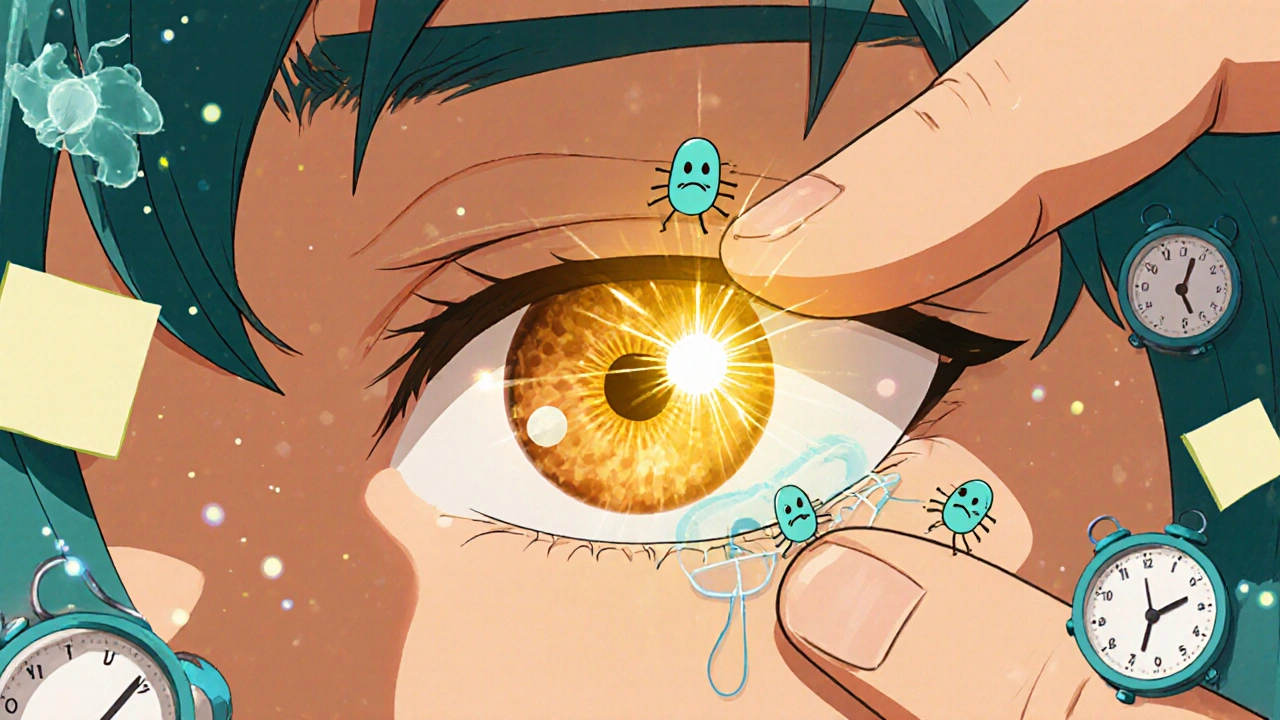
Side Effects - What’s Normal and What’s Not
Besifloxacin is generally well-tolerated. But some people experience mild side effects:
- Temporary stinging or burning right after the drop (lasts less than a minute)
- Blurred vision for a few seconds
- Itchy or dry eyes
These are normal and usually go away as your eye adjusts. But if you notice:
- Severe pain or swelling
- Increased redness or pus
- Vision loss or floaters
- Rash around the eye or swelling of the face
Stop using the drops and call your doctor immediately. These could signal an allergic reaction or a worsening infection.
How to Store Besifloxacin Eye Drops
Keep the bottle tightly closed and store it at room temperature - between 15°C and 25°C. You don’t need to refrigerate it. Avoid leaving it in hot places like your car or near a sunny window. Heat can break down the active ingredients.
If you’re traveling, keep it in your carry-on. Don’t pack it in checked luggage. Extreme cold or heat can ruin the medication.
When to See Your Doctor Again
You should feel improvement within 48 hours. Redness should start to fade. Discharge should decrease. If you don’t see any change after two days, or if your vision gets worse, don’t wait. Go back to your doctor.
Also, schedule a follow-up even if you feel fine. Your doctor may want to check that the infection is truly gone. Some corneal ulcers can heal on the surface but still be active underneath. A quick exam with a special light can catch that.
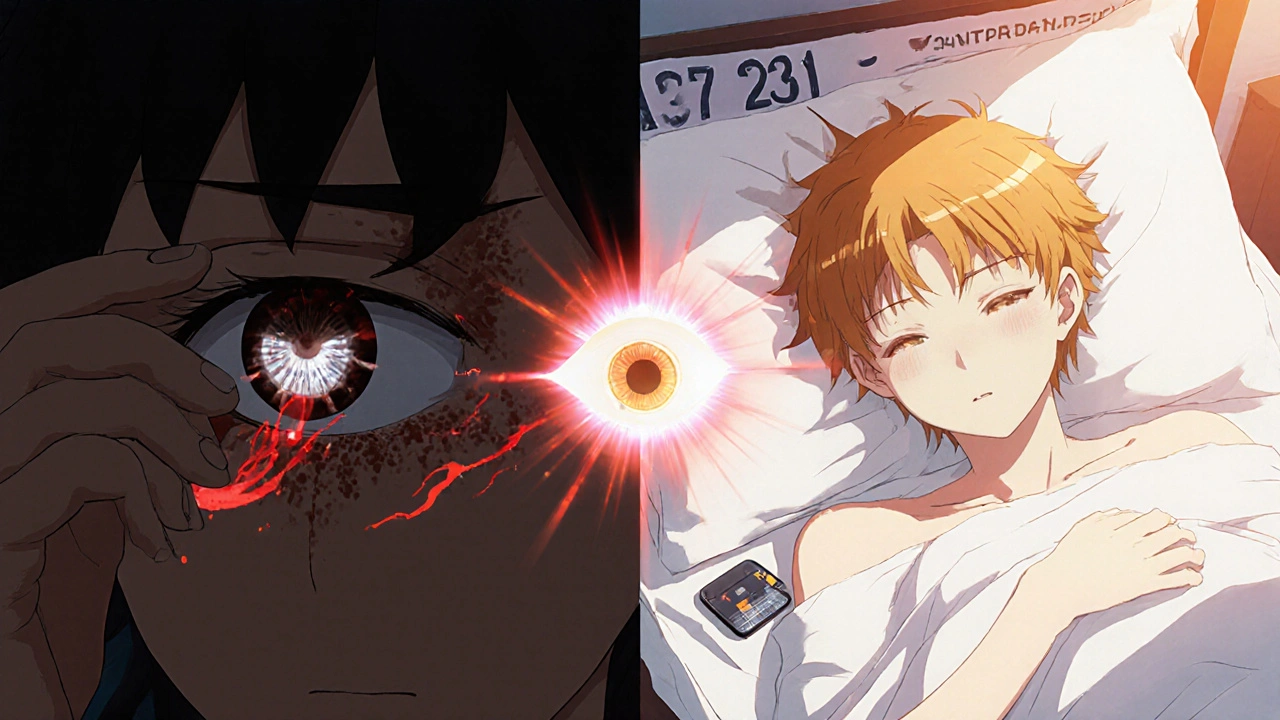
What Happens If You Miss a Dose?
If you forget a dose, take it as soon as you remember. But if it’s almost time for the next one, skip the missed dose. Don’t double up. Taking too much can irritate your eye without helping more.
Keep a simple log: write down the time you used each drop. Even a sticky note on your bathroom mirror helps. People who track their doses are 60% more likely to finish their course successfully, according to a 2024 study in the New Zealand Journal of Ophthalmology.
Alternatives to Besifloxacin
Besifloxacin isn’t the only option. Other antibiotic eye drops include ciprofloxacin, moxifloxacin, and tobramycin. But besifloxacin has advantages: it’s formulated to stay in the eye longer, so you don’t need to use it as often as some others. It also has a lower risk of causing resistance.
If you’re allergic to fluoroquinolones (the class of antibiotics that includes besifloxacin), your doctor might choose a different type, like azithromycin drops. Always tell your doctor about any allergies you have.
Final Tip: Don’t Rush Recovery
Your eye might feel better before the infection is fully gone. That’s why finishing the full course matters. Pushing yourself to return to screen time, swimming, or wearing contacts too soon can trigger a relapse.
Give your eyes time. Rest them. Use artificial tears if they feel dry - but only if they’re preservative-free and approved by your doctor. Avoid rubbing your eyes. Even if they itch, that’s the worst thing you can do.
Most people recover fully with besifloxacin - if they follow the steps. It’s not magic. It’s consistency.
Can I use besifloxacin eye drops while wearing contact lenses?
No. Remove your contact lenses before using besifloxacin eye drops. Wait at least 15 minutes after applying the drops before putting your lenses back in. Many doctors recommend avoiding contacts entirely until the infection has completely cleared, which can take up to a week or longer. Bacteria can cling to contact lenses and cause the infection to return.
How long does it take for besifloxacin to work?
Most people notice improvement within 48 hours - less redness, less discharge, less discomfort. But it can take 5 to 7 days for the infection to fully clear. Don’t stop using the drops just because you feel better. Finish the full course as prescribed, even if symptoms disappear early.
Can besifloxacin eye drops cause blurred vision?
Yes, temporary blurred vision is common right after applying the drops. It usually lasts less than a minute. Don’t drive or operate machinery until your vision clears. If blurred vision lasts longer than 5 minutes or gets worse, stop using the drops and contact your doctor.
Is it safe to use besifloxacin eye drops for children?
Yes, besifloxacin is approved for use in children aged 1 year and older. The dosage and frequency are the same as for adults - one drop three times a day. Always supervise children when they’re using eye drops to ensure proper application and avoid contamination.
What should I do if I accidentally swallow some of the eye drops?
Swallowing a small amount of besifloxacin eye drops is unlikely to cause serious harm, but it can cause a bitter taste or mild stomach upset. To avoid this, press gently on the inner corner of your eye (near the nose) for 30 seconds after applying the drop. This blocks drainage into the tear duct and throat. If you swallow a large amount or feel unwell, contact a poison control center or your doctor.
Can I use besifloxacin eye drops for pink eye caused by allergies?
No. Besifloxacin only works on bacterial infections. Allergic pink eye is caused by allergens like pollen or dust, not bacteria. Using antibiotics when they’re not needed won’t help and can increase the risk of antibiotic resistance. For allergic conjunctivitis, antihistamine eye drops or cold compresses are more appropriate.
Next Steps: What to Do After Your Course Ends
Once you’ve finished your prescription, don’t just toss the bottle. Keep it for a few days in case symptoms return. If your eye starts acting up again - even mildly - call your doctor. Recurring infections can signal an underlying issue, like a blocked tear duct or chronic dry eye.
Also, replace your contact lens case if you used lenses during the infection. And wash your pillowcases, towels, and anything that touched your face. Bacteria can linger on fabric and reinfect you.
Finally, consider keeping a small bottle of preservative-free artificial tears on hand. Many people find their eyes feel drier after an infection clears. Gentle hydration helps your eyes heal completely.
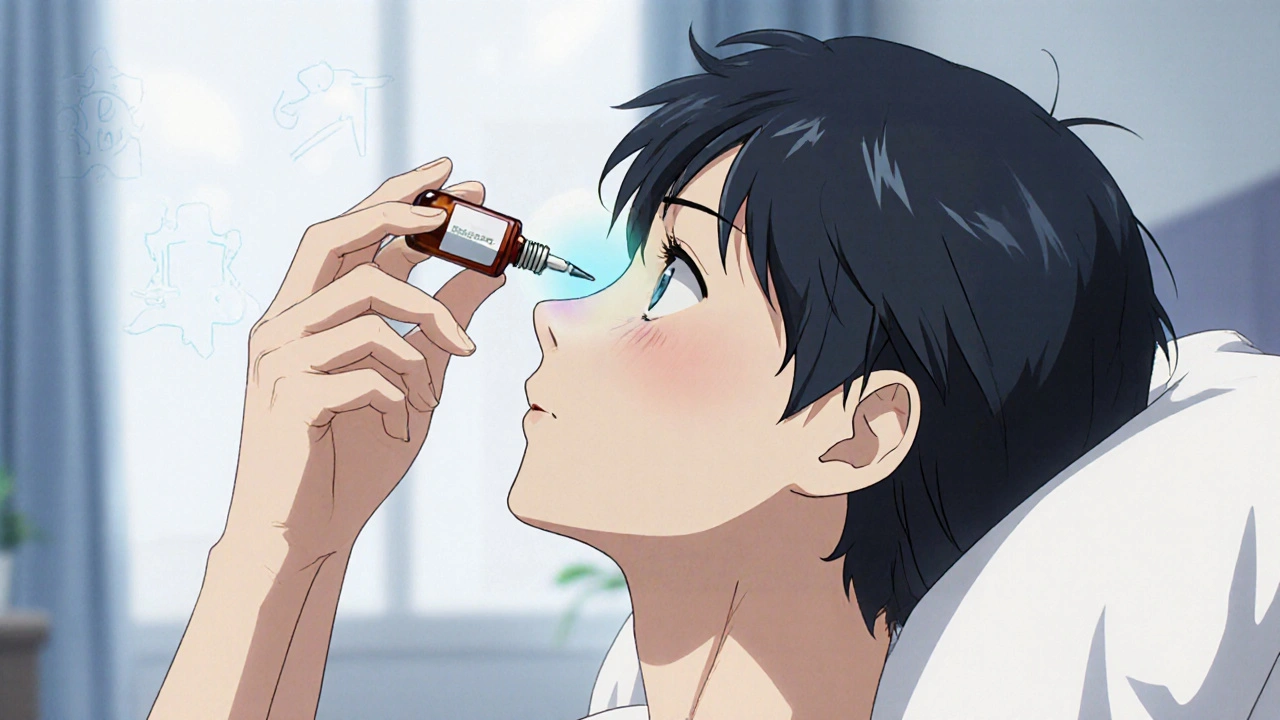
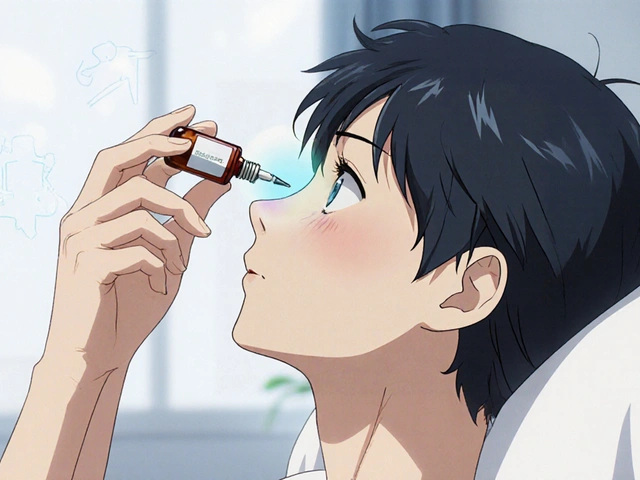
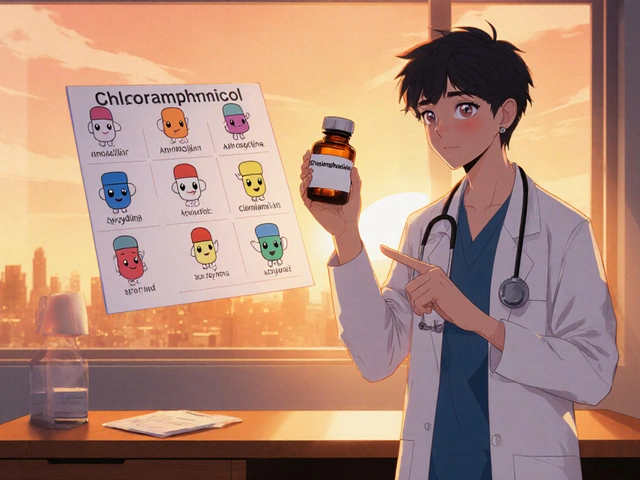

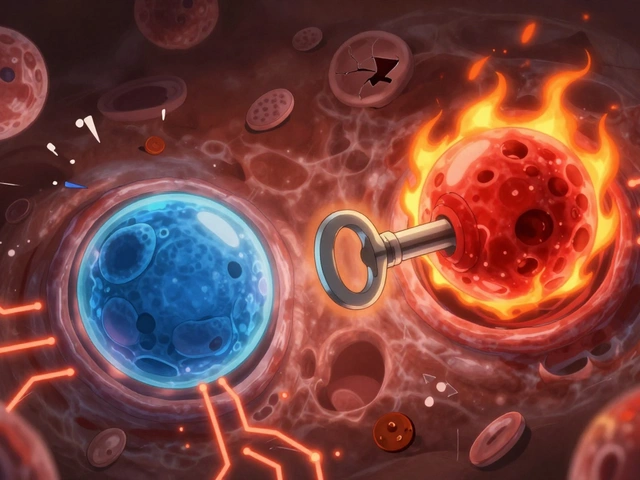
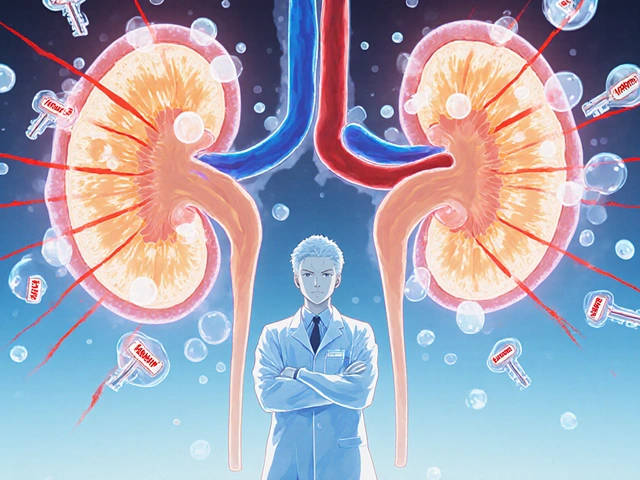
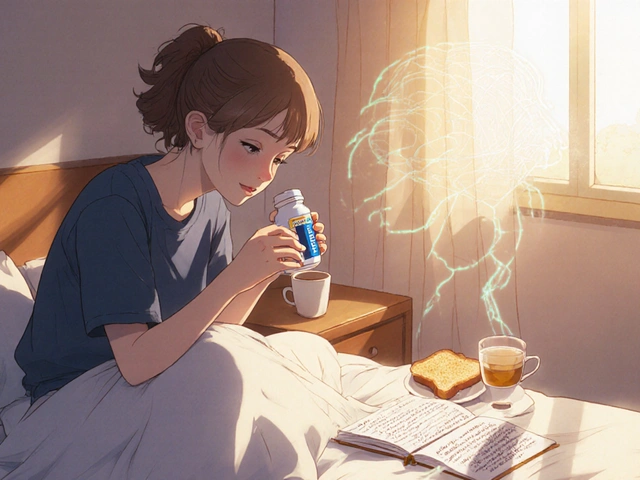
Write a comment
Your email address will be restricted to us